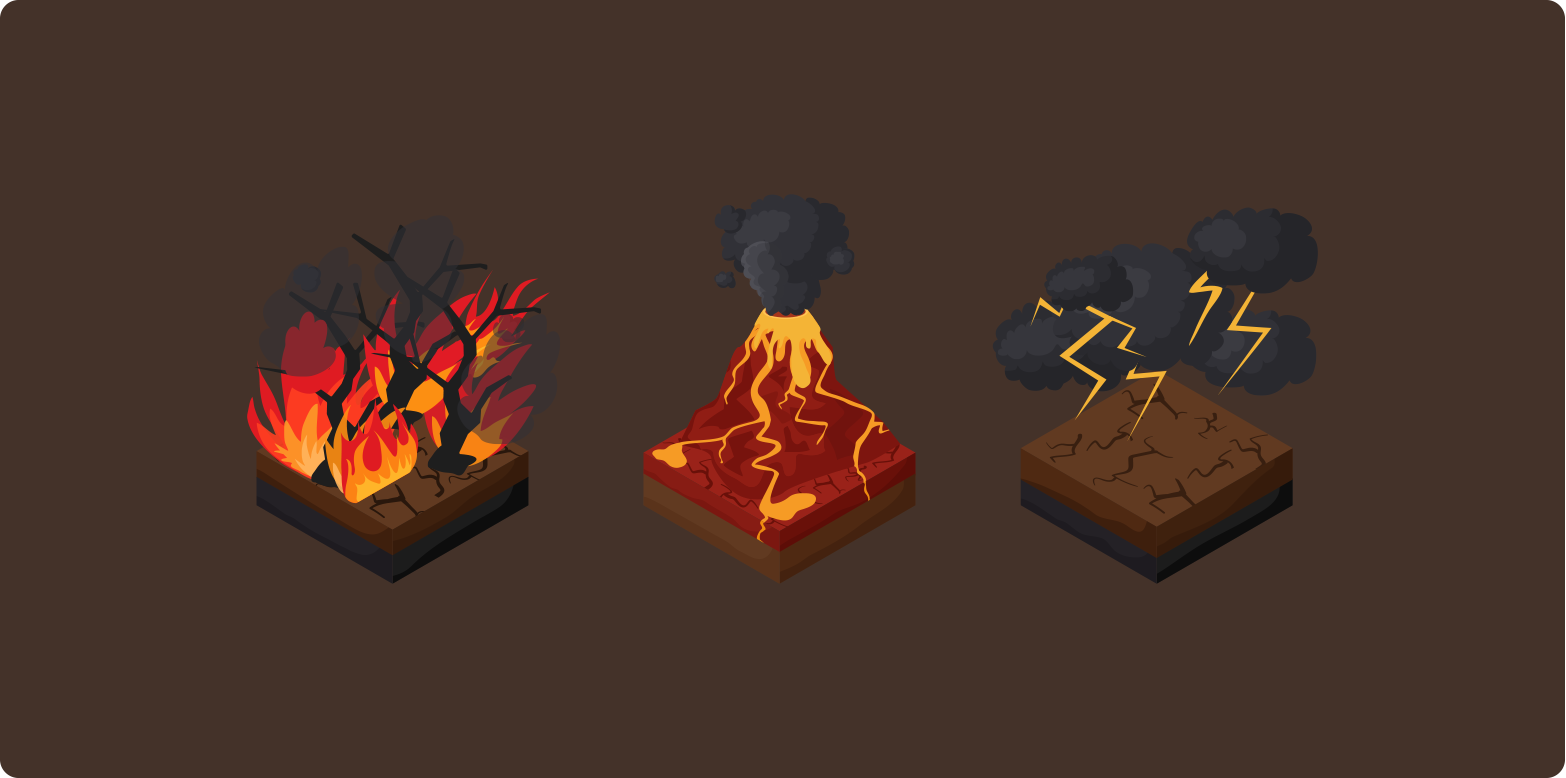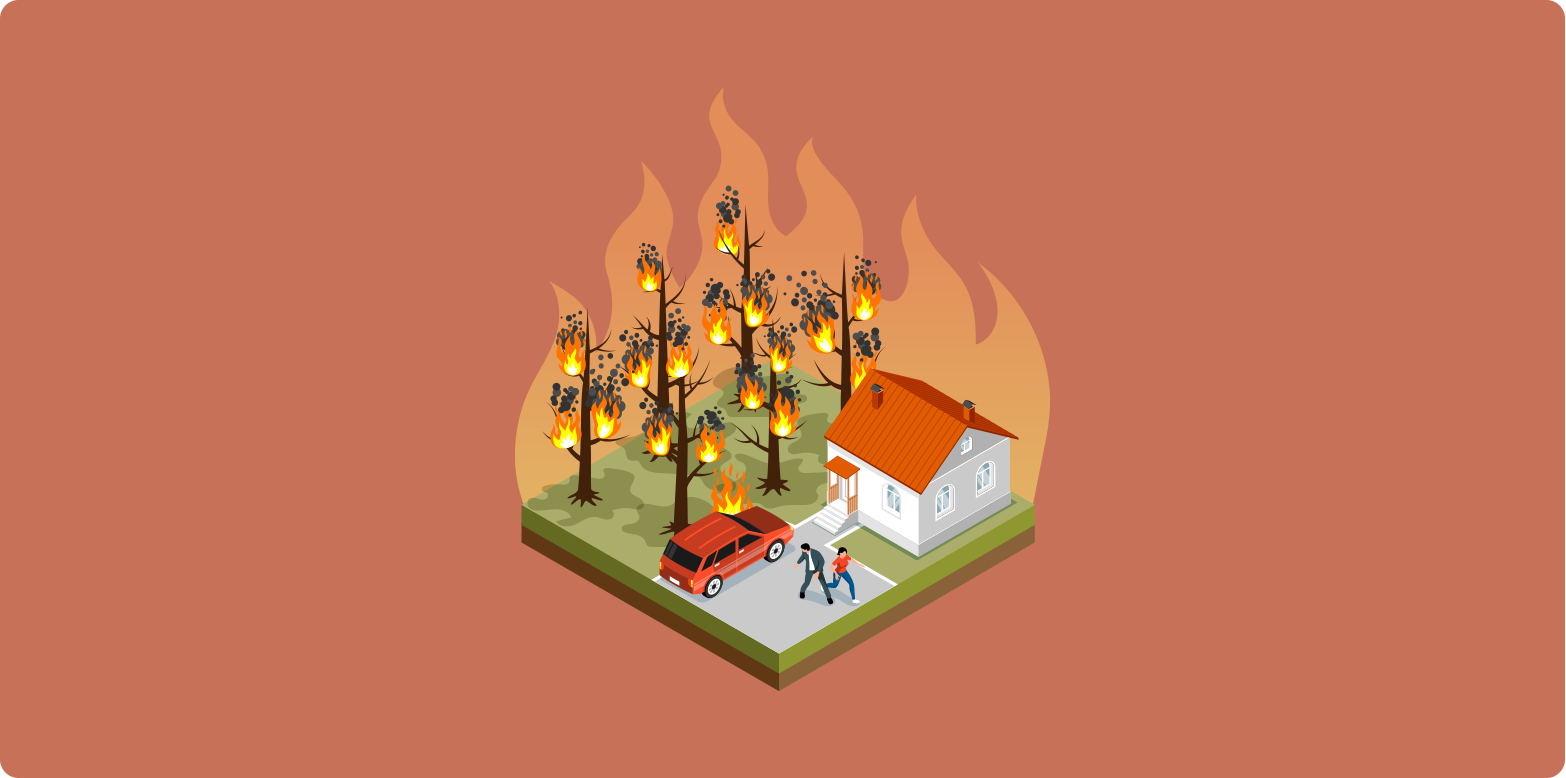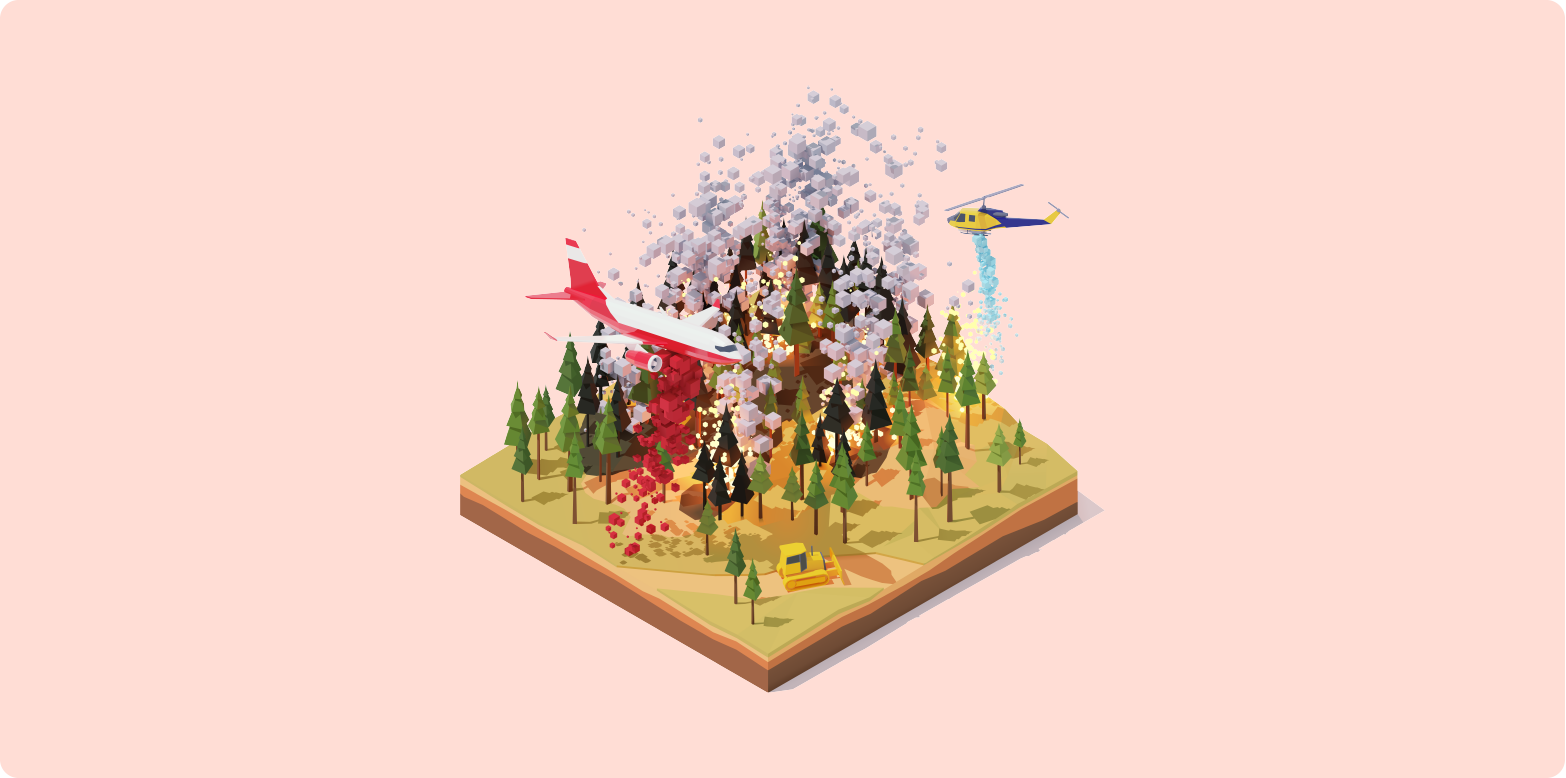Wildfires and Forests: How Wildfires Affect Our Health and Our Planet
ALCHERA
January 6, 2023
January 6, 2023
The World Is on Fire. Literally.
Table of Contents
Wildfires: How Do They Happen, and Are They Necessarily Bad?
• What causes wildfires?
• Not all wildfires are equal. How do different types of wildfires affect an ecosystem?
Impact of Wildfires on Human Health
• Effect of wildfires on human health
Latest Wildfire Technologies
• Firefighting technologies
• Fire prevention technologies
California, Canada, Australia, Brazil, and Siberia. What do they have in common?
The answer is severe wildfires, which bring sweeping damage to ecosystems, people, and economies. Every year, hundreds of people lose their homes, and sometimes their lives, due to wildfires. Repeated drastic wildfires have pushed dozens of plant and animal species to the brink of extinction. How can we protect ourselves and our ecosystems from wildfires?

Wildfires: How Do They Happen, and Are They Necessarily Bad?

What causes wildfires?
A wildfire is an uncontrolled fire that burns in wildland vegetation. Wildfires are not limited to a particular continent or environment. Wildfires can burn in savannas, grasslands, forests, and other ecosystems.
Wildfires can occur because of natural factors, such as lightning strikes, or can be human-caused. But it is weather conditions that determine how destructive a wildfire will be. Weather factors include rainfall, temperature, and wind. The higher the temperature and the lower the rainfall in an ecosystem, the drier leaves and limbs become, providing perfect fuel for conflagrations. Strong wind aids combustion by increasing oxygen supply, making it harder to fight a fire using aerial methods like helicopters.
Landscape matters too; for example, flames burn faster uphill than they do downhill. Wind speeds and convection winds are greater on the upper slopes of a landscape because of elements like drainage, canyons, and saddles.
Not all wildfires are equal. How do different types of wildfires affect an ecosystem?
Low-intensity wildfire
Wildfire is a natural and essential component of many ecosystems. Periodical burning is needed to release nutrients stored in the litter on the forest floor and get rid of dead and fire-prone vegetation. Periodical burnings fall into the category of low-intensity wildfires. Low-intensity wildfires shape vegetation patterns. Brush, grasses, and small trees are burned, removing vegetation ladders that enable wildfires to reach and spread through the tree canopy. This in turn opens areas in the canopy that allow sunlight and precipitation to reach the forest floor. During low-intensity wildfires, tree trunks and roots stay intact, keeping forests alive and minimizing soil erosion into streams and lakes. Ashes of burnt plants enrich the soil, and green leaves and plants continue to absorb carbon dioxide and produce oxygen.
It may sound counterintuitive, but low-intensity wildfires help reduce the risk of large-scale high-severity wildfires. However, low-intensity wildfires are possible only in undisturbed ecosystems in a steady-state climate, where a balance between wildfires and vegetation growth is established.
Unfortunately, today, there exist almost no ecosystems unaffected by human intervention.
Thus we arrive at high-severity wildfires.
High-severity wildfire
In the past, high-severity wildfires were infrequent events that were hard to control but still manageable. As we have witnessed in recent years, high-severity wildfires are no longer infrequent and have become harder to cope with. High-severity wildfire are fires with a 75% tree mortality rate and extensive mineral soil exposure.
As a result of a massive tree and green mortality, rodents can’t find seeds to eat, and grazers have no leafy meals. Carnivores no longer have prey to hunt. Ash and debris flow into lakes and streams, damaging water sources and disrupting the lifecycle of aquatic species like fish and frogs. Scorched soil is no longer suitable for pine forests to regrow, and forests may be replaced with invasive grasses or low scrub.
Change in habitat forces roaming species, like fishers, to become isolated in smaller areas where they may not find mates or adequate food.
CO2 emissions from wildfires are enormous and worsen the overall environmental crisis.
Wildfires affect not only animals, vegetation diversity, and climate, but also humans.
Impact of Wildfires on Human Health

Wildfires have a negative impact on the physical and mental health of the people affected by them. People close to a fire source can lose their homes and their loved ones, and many have to go through the stressful process of evacuation.
There are also less obvious but equally or even more dangerous consequences of exposure to wildfire and smoke from a wildfire.
Effect of wildfires on human health
Effect of wildfires on respiratory health
One of the greatest dangers of wildfires is particle pollution in smoke. Particle pollution is a mix of very tiny liquid and solid particles in the air. These particles are no larger than one-third the diameter of a human hair. Because these particles are so small, they can lodge deep in the lungs, causing serious health problems.
Almost all research that has investigated associations between smoke exposure and respiratory health outcomes has found significant associations with asthma exacerbation. People who breathe smoky air during wildfires tend to have more coughing, wheezing, bronchitis, and colds. The lining of the lungs becomes inflamed, which leads to difficulties in breathing.
Effect of wildfires on cardiovascular health
Exposure to wildfires and smoke from wildfires has been found to be related to a higher risk of heart disease. Short-term, less than 3 hours’ exposure to smoke from wildfires has the potential to increase heart rate and central arterial stiffness, decreasing heart rate variability. According to Fay Johnston, an environmental epidemiologist at the University of Tasmania in Hobart, Australia, when smoke from wildfires enters the airway, the body reacts to it the same way it reacts to germs and infection: The hormone cortisol and blood glucose raise, which in turn makes heart rhythms unstable and blood more likely to clot.
Other effects of wildfires on physical health
Some studies reveal a significant correlation between exposure to smoke from wildfires and a small but significant decline in birth weight.
Other research finds a marked increase in the number of influenza cases (after intense forest fires in Montana, USA). Still other findings suggest that people could be more vulnerable to respiratory infections after exposure to smoke from wildfires. For example, people who have experienced the consequences of wildfires may be more vulnerable to COVID-19. Related studies are currently being conducted.
Another danger that smoke from wildfires brings is carbon monoxide (CO) - a colorless, odorless gas that reduces oxygen delivery to the body’s organs and tissues and can lead to nausea, dizziness, and headaches. In high concentrations, carbon monoxide can lead to death.
Besides CO, wildfires spread many other harmful emissions, such as nitrogen oxides and other air pollutants.
Effect of wildfires on mental health
Emergency evacuation and the human loss of physical and social environments are hugely stressful experiences. People who have been directly exposed to wildfire are at greater risk of posttraumatic stress disorder (PTSD), depression, and anxiety disorders. Thus, it is important to provide not only physical medical support, but also psychological medical support, to survivors.
As we can see, high-severity wildfires are literal disasters for the planet and the humans who inhabit it.
The importance of the prevention of severe wildfires can’t be overestimated.
Luckily, modern technologies provide highly efficient solutions for wildfire prevention. Let’s see what they can offer.
Latest Wildfire Technologies

Firefighting technologies
I4F: Instant foam for fighting forest fires
For centuries, water was the only way to fight fires. But researchers have developed a more effective tool - I4F, an instant foam. 14F is a flame-retardant mix of water and the I4F material, which is more effective than water alone. 14F is also cheaper and more environmentally friendly than other existing foam retardants.
Infrared imaging
Infrared technology allows firefighters to see through thick smoke, which normally blocks visibility and makes firefighting more difficult and dangerous.
Drones
Drones are widely used for aerial photography and in the performing arts. But they are also beneficial for fighting wildfires because they can fly in conditions that helicopters and planes cannot. And, since they don’t require human pilots, they do not put firefighters’ lives at risk.
Fire prevention technologies
Computer modeling
Computer modeling helps assess risks before fires start during critical weather conditions such as lightning storms and hot, dry winds. Using computer modeling, experts can forecast daily risk, tracking factors like dryness of vegetation. Firefighter crews and equipment can be located in high-risk areas so that immediate response is possible.
Fire urgency estimator in geosynchronous orbit (FUEGO)
FUEGO is a system developed by Berkley astrophysicist Carlton Pennypacker and his team. The FUEGO system uses satellites placed in orbit around the Earth to monitor sensitive areas, allowing for early detection and rapid response if a fire breaks out.

Artificial intelligence
Artificial Intelligence is one of the most promising technologies of the century. It is extremely helpful in almost every sphere of human life. Firefighting and fire prevention are no exceptions.
Two main AI approaches are used to prevent wildfires: sensor-based and image-based.
● Sensor-based approach. As one might guess from the name, in this approach, various sensors that make predictions about fire occurrence are installed in the forest. These sensors measure the amounts of hydrogen sulfide, carbon dioxide, carbon monoxide, and oxygen in the atmosphere. This data is coupled with information about temperature and humidity levels to make precise predictions about the possibility of fire.
● Image-based approach. Here, the neural network is trained to detect fires based on video data gained through cameras. Once the model has learned the features of wildfires and smoke from wildfires from the massive database, it is ready for real-life application. The technology principle is very similar to that of an object detection model. When AI detects any anomaly, it immediately sends an alarm to the authorities so that necessary action can be taken in the shortest time possible.
The image-based approach is preferable since it doesn’t require additional hardware; existing cameras are enough.

ALCHERA provides a world-class, cutting-edge fire detection solution - FireScout. FireScout is the only both day and nighttime wIldfire detection solution available on the market.
FireScout detects smoke from wildfires and other fires at night via infrared (IR) cameras. This makes AI the wildfire detection solution that never sleeps. Fire and smoke detection are possible 24/7/365. Our AI-based solution detects wildfire within the “golden time” of 10 to 20 minutes, which allows authorities to manage wildfires early. FireScout reduces human error in the process of analyzing video data and makes the data-analyzing process more affordable.
Join FireScout in detecting to protect. Fight wildfires with our unbeatable technology, and lessen their devastating impact on human life, the environment, and the world.
...
...